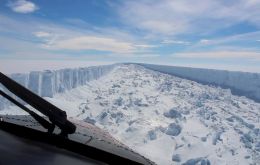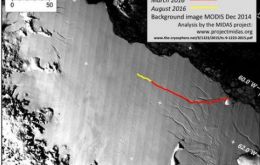MercoPress. South Atlantic News Agency
Tag: ice shelf in Larsen C
-
Thursday, July 13th 2017 - 08:53 UTC
Huge iceberg breaks free from the Antarctica Larsen C ice shelf

An iceberg the size of Delaware has broken free from an Antarctic ice shelf, leaving the rest of the shelf vulnerable to collapse and serving as a harbinger of future sea-level rise that could pose a serious threat to coastal communities such as the Falkland Islands.
-
Thursday, June 1st 2017 - 20:57 UTC
Antarctica largest iceberg ever, ready to break off from the Larsen C ice shelf

The long-growing crack in the Larsen C ice shelf, one of Antarctica’s largest floating platforms of ice, appears to be reaching its inevitable end. Scientists with Project MIDAS, working out of Swansea University and Aberystwyth University in Wales and studying the shelf by satellites and through other techniques, have released a new update showing that the crack grew a stunning 11 miles in the space of just one week between May 25 and May 31.
-
Tuesday, May 2nd 2017 - 22:31 UTC
BAS describes how warm, dry winds weaken Antarctic ice shelves

New research describes for the first time the role that warm, dry winds play in influencing the behaviour of Antarctic ice shelves. Making a presentation at a European conference scientists from British Antarctic Survey (BAS) explain how spring and summer winds, known as föhn winds, are prevalent on the Larsen C Ice Shelf, West Antarctica and creating melt pools.
-
Wednesday, December 7th 2016 - 21:54 UTC
Massive rift in Antarctica: could become the largest iceberg since 2000

A massive rift in the Antarctica has been spotted by NASA, but the troubling details about the rift is causing the agency to worry. The ice shelf in Larsen C that is close to breaking off is as big as the size of the state of Delaware.
